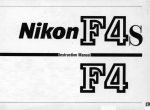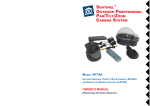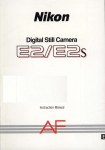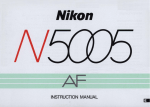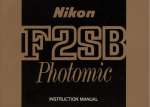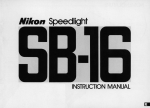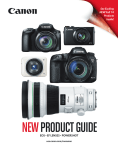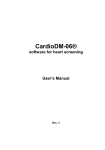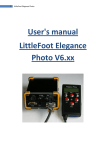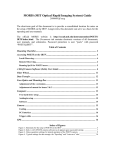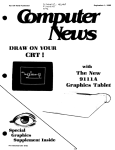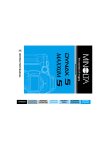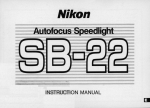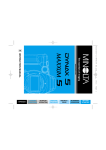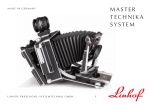Download Nikon N4004s User's Manual
Transcript
Nikon INSTRUCTION MANUAL ~------------------ CONTENTS ------------------~ FOREWORD ........ ....... ... ... ... .......... 3 NOMENCLATURE ... ........ .... ... ... ... 4-6 BASIC OPERATION ...... 7-15 MOUNTING THE LENS ....................... . . .............. 7 INSTALLING BATTERIES ................ ....... ... .8 CHECKING BATTERY POWER .......... .. . ... ........ 9 LOADING FILM ............................... . ..... 10-11 BASIC SHOOTING .. ... ...... 12-14 REWINDING FILM ........ ............. 15 FOCUS ..... ... .. ... .. ...... 16-21 AUTOFOCUS .. ................. . .... 16-17 Taking Pictures with an Off-Center Main Subject.. .. . 16 Autofocu sing with AF Illuminator .............................. 17 MANUAL FOCUS WITH ELECTRONIC FOCUSING CONFIRMATION .............................. 18 MANUAL FOCUS USING CLEAR MATTE FIELD ... 19 SPECIAL FOCUSING SITUATIONS .. . . ... 20-21 EXPOSURE .... 22-39 .......... 22 Shutter Speed Dial and Aperture Dial .. PROGRAM AUTO EXPOSURE MODE . ......... 23 SHUTTER-PRIORITY AUTO ..24-25 EXPOSURE MODE ............................ . APERTURE-PRIORITY AUTO EXPOSURE MODE .. ....... ......... ..... . ..... 26-27 MANUAL EXPOSURE MODE .. .28-29 EXPOSURE METERING SYSTEM ................ 30-39 Advanced Automatic Exposure Con trol with Nikon 's Exclusive Multi-Sensor Metering System ... ...30-31 Centerweighted Metering . ... .. .. ... .. ..... ....... .... 31 2 Multi-Sensor vs. Centerweighted Metering .. .. 32 -35 Centerweighted Metering for Special Exposure ... 36-37 Situations. ............................................. AEL (Auto Exposure Lock) Button ............................ 36 Manual Exposure Mode . ....... ... .. .. ........ ...... ... ....... ... 37 Balanced Fill-Flash Photography with MUlti-Sensor Metering System. ........ 38-39 FLASH PHOTOGRAPHy . . . . .. . . . .... . ..... 40-44 ......................... 40-41 BUILT-IN TTL FLASH Shooting Dark Subjects. ........ ............................ 40 . 41 Automatic Balanced Fill-Flash Photography .. . FLASH PHOTOGRAPHY USING EXTERNAL SPEEDLIGHT .. ... 42 -43 SHUTTER SPEED - FLASH MODE COMBINATIONS FOR EACH EXPOSURE MODE ............ 44 READY-LIGHT WARNINGS ....................... 44 SELF-TIMER ... ......... ..... ... ... ..... ..... 45 CAMERA CARE TIPS .. ............... ............... ... .. 46-47 NOTES ON BATTERIES .... ... .. .. ....... ... .. .... , ............ .. .. 48 LENSES ...... .. ....... ... ..................... ........ .. ... .. ........... 49-50 ACCESSORY COMPATIBILITy.................. ... .. . 51 EXPOSURE VALUE (EV).. .. ... ... .... .... ....... .. .. .... 52-53 GLOSSARY ... ... ...... .. ..... ... ... ... ..... ... .. .. ... .. .. ..... .. .. ... 54-55 .56-58 SPECiFiCATIONS ......... ... .................... VIEWFINDER INFORMATION .......... .. .......... .. .... ... ... 59 ~--------FOREWORD --------~ Thank you for purchasing this Nikon product. We hope you enjoy the Nikon N4004s, and we're sure it will make photography a bigger part of your life. For the first time ever, we are incorporat· ing Nikon's exclusive Decision Master System, a complete system that integrates camera and lens computers to give you automatic control of all picture taking operations, and makes the Nikon N4004s an absolute joy to use. Get to know your N4004s, but before using it, be sure to read this manual thoroughly. Nikon cannot be held responsible for malfunction resulting from the use of the Camera other than as specified in this manual. Your Nikon camera requires precise electronic and mechanical matching between component products -such as lenses and electronic flash. Nikon brand lenses and electronic flash units are made to Nikon's factory specifica· tions and will operate properly and in accordance with the Nikon Limited Warranty that was provided with your products. Damage to your Nikon product, as a result of malfunction or improper connections, caused by the use of Non-Nikon brand products, is not covered under the terms of the Nikon Limited Warranty and will void the Nikon warranty. 3 NOMENCLATURE Focusing ring Distance scale window Focal length scale Aperture indexes Aperture ring Meter coupling ridge Lens (AF Zoom·Nikkor 35 - 70mm fl3.3 - 4.5) Distance scale Distance/local length index line Zoom ring Aperture scale Minimum aperture lock AF contacts Flash head Self·timer indicator LED AEL (Auto Exposure Lock) button Aperture coupling lever Handgrip Battery ohamber Minimum aperture lever AF coupling Tripod socket 4 AF contacts Lens mounting index Lens release button Focus mode selector Camera back lock release Lens release pin Lens mounting flange Reflex mirror [[QJ] Flash lock-release buttons Eyepiece cover DK-5 Shutter speed dial Dial lock-release button Shutter release button Accessory shoe Camera strap eyelet Self-timer button Film plane indicator Film cartridge confirmation window Camera back Film rewind button Camera strap eyelet Frame counter Film rewind lever Film advance indicator Aperture dial 5 Inside Viewfinder 12mm·dia. central area Clear matte field Focus brackets Focus indicator LED Exposure indicator LEOs Flash ready·light Film sprocket Film take·up spool Film pressure plate Viewfinder eyepiece Film rewind fork OX contacts Film cartridge chamber Shutter curtains Film guide rails 6 Film pressure roller Film leader index Battery chamber lock release BASIC O P E R A T I O N - - - - - - - - - - - - - - - - - MOUNTING THE LENS Twist lens counterclockwise until it securely clicks into place. To remove Do not push lens release button except when removing lens. Set lens to its smallest aperture (largest f·number), then turn minimum aperture lock to lock position . •••••••••••••••••••••••• •• ••• • •• •• •• •• • •••••••••••••••••••••••••••• The N4004s is designed for use with AF Nikkor lenses, except AFNikkor BOmm f/2 .B, 200mm f/3 .5 IF-ED, and Autofocus Converter TC-16ITC-16A. For limited use of non-AF Nikkor lenses, see page 49. •••••••••••••••••••••••• : : • : • : • With the N4004s, all aperture setting operations are performed using the aperture dial on the camera body. Do not move lens ' aperture ring once it is set to its smallest aperture (largest I-number). •• ••••••••••••••••••••••••• 7 INSTALLING BATTERIES 3 Open the battery chamber lid by sliding the lock release. Install four fresh AA-type batteries with "+ " and " - " ends positioned as shown inside the battery chamber. •••••••••••••••••••••••• • Batteries with a "+ " terminal ex: ceeding 6mm in diameter cannot be used. • : • •• • •••••••••••••••••••••••• 8 Close the battery chamber lid. CHECKING BATTERY POWER 6 ~----------- Exposure indicator LED(s) lights up or blinks if power is sufficient, and stays on approx. 8 sec. after you take your finger off the button. Lightly press shutter release button and check viewfinder exposure indicator LED(s) to make sure battery power is sufficient. ••••••••••••••••••••••••• : : • : • : Battery power can also be checked by film advance speed, operation speed of autofocus lens or flash recycling time. When these become noticeably slower, c hange batteries. : : • : • : If LED goes off approx. 2 sec. after finger is removed from button, batteries need replacement. No LED, and shutter locks. Check battery installation or change batteries. • • • •••••••••••••••••••••••••••••••••••••••••••••••••• •• • : The microcomputer in the N4004s may turn the camera off, even when : : •••••••••••••••••••••••••••• : batteries with sufficient power are properly installed. To start or resume • operation , remove batteries and install again. • •• •• ••••••••••••••••••••••••••••••••••••••••••••••••••• 9 LOADING FILM 7 Slide down camera back lock release to open camera back. Insert film cartridge. • ••••••••••••••••••••••• • Use on ly OX-coded fi lm. • Usable film speed range for OX-coded film is ISO 25 to 5000 . • All non-OX-coded films are automatically set to ·ISO 100. • Avoid loading/unloading in direct sunlight. ••••••••••••••••••••••• 10 Pull film leader out to red index mark. Check to make sure film is positioned properly, with no slack. Close camera back and confirm lockrelease snaps closed . Fully depress shutter release button to automatically advance film to frame "1 ." Observe film advance indicator rotation to confirm proper film installation and transport. 11 BASIC SHOOTING The Nikon N4004s offers both auto and manual focusing. It also gives you three auto exposure modesprogram auto, aperture-priority auto, shutter-priority auto-plus manual exposure control. The following instructions are for autofocus shooting in program auto exposure mode with an AF Nikkor lens. Program mode is the easiest to use and most automatic exposure mode. For details about other focusing methods and exposure modes, see pages 18 to 21 and 24 to 29, respectively. •••••••••••••••••••••••• •• : • •••••••••••••••••••••••• ••• ••• •• •• •• •• • • When both A and S are set, program auto mode is in operation. 12 • •• •• The shutter dial locks at the A or L position, and the aperture dial locks at the S position. To release them , rotate the shutter or aperture dial while pressing the dial lock-release button. •• ••• •• ••• • ••••••••••••••••••••••••• •••••••••••••••••••••••• Confirm lens is set to smallest aperture (largest f-number); if lens is incorrectly set, the shutter release locks and + and - LEOs blink alternately. Set focus mode selector to A (autofocus ). If the lens in use has an A-M switch , set the switch to A. Set shutter speed dial to A, and aperture dial to S. Aim camera at the subject. 16 Lightly press the shutter release button . Position the viewfinder focus brackets on the main subject. Confirm the green focus indicator LED . and the red exposure indicator LED 0 light up . •••••••••••••••••••••••••••••••••••••••••••••••••••••••••••••••••••••••••••••• •• • •• •• •• •• • •• + •• • • •• •• •• • •• • • * Shutter is locked. • • •• • •• ••••••••••••••••••••••••••••••••••••••••••••••••••••••••••••••••••••••••••••••••• •• ••• • ••• • •• ••• • • If focus indicator LED • blinks, see page 20. • If subject moves and the focusing distance changes , refocus by briefly removing finger from shutter release button and lightly pressing again to reactivate autofocus function . • Picture blur possibility (shutter speed is 1/30 sec. or slower). Use tripod to avoid camera shake, or use built·in TTL flash or accessory Nikon speedlight to synchronize shutter speed at 1/100 sec. 2) lights up' Overexposure warning. Too brigh~-very rare condition ; use film with lower ISO speed. 3) - lights up' Underexposure warning. Too dark-use built'in flash or accessory Nikon speed light. 4) J blinks Use built·in TTL flash or accessory Nikon speedlight. 1) 0 blinks 13 •••••••••••••••••••••••••••••••••••••••••••••••••••• : Flash shooting with built·in TTL flash ••• •• •• •• •• : ••• ••• • • 1. Push flash lock release buttons to release built-in flash. Check to make sure subject is within proper flash shooting range for film speed in use. If subject is beyond flash shooting range, ready-lig ht LED blinks for approx. 3 sec. after releasing the shutter. For details, see page 40. 3. Wait a few seconds for readylight to come on , then shoot. •••••••••••••••••••••••••••••••••••••••••••••••••• 14 Fully depress shutter release button to take picture. This automatically advances film by one frame . 2. Lightly press shutter release button to turn on the N4004s. •••••••••••••••••••••••• • • Upon shutter release, the exposure indicator LED(s) turns off approx. 2 sec. after you remove your finger from the button . -I f camera detects abnormality during fi lm advance (when film is loaded), the self-timer indicator LED lights up for a few seconds. If this happens, set the shutter speed dial to L (lock), then proceed as usual. ••• • ••• ••• ••••••••••••••••••••••• •• •• ••• • -- REWINDING FILM The film advance stops automatically at the end of the roll. Then, the self-timer indicator LED lights up for a few seconds and the shutter locks . While sliding film rewind lever, push the film rewind button . After rewinding stops (automatic), confirm film frame counter has returned to "S". ••••••••••••••••••••••••• ••• • •• •• • ••• • •• •• •• •• •• •• •• • • • ••••••••••••••••••••••••• If you do not rewind the film when you come to the end of the roll , each time the shutter rel ease button is depressed, the self-timer indicator LED lights up for a few seconds to remind you to rewind it. Open camera back and remove film cartridge. 15 FOCUS,--------------------------------------------- AUTOFOCUS In autofocus mode, the shutter cannot be released until the subject is correctly focused , and once in focus , the foc us is locked as long as the shutter release button remains lightly pressed. Taking Pictures with an Off· Center Main Subject 1. Center the focus brackets on the subject and lightly press the shutter release button. 2. Confirm the focus indicator LED lights up. 16 3. Keeping the shutter release button lightly pressed, recompose and fu lly depress the shutter release button. Autofocusing with AF Illuminator II existing light is insufficient lor autolocus operation: 1. Mount Nikon Autolocus Speed light S8·24/S8·23/S8-22/ S8-20 on the accessory shoe 01 the N4004s. 2. Lightly press the shutter release button. 3. The speedlight's AF illuminator lights up to start autofocus operation. For details, see speedlight instruction manual. 17 MANUAL FOCUS WITH ELECTRONIC FOCUSING CONFIRMATION ~------------------------~ 1. Set focus mode selector to M (manual). If the lens in use has an A-M switch, set the switch to M. 2. Look inside vewfinder and center the 4. Keeping the shutter release button lightly pressed, watch the focus indicator LED in the viewfinder and rotate the lens focusing ring manually until the focus indicator LED lights up. 18 3. Lightly press the shutter release button. focus brackets on the main subject. 5. Fully depress the shutter release button. MANUAL FOCUS USING CLEAR MATTE FIELD 1. Set the focus mode selector to M (manual). 2. Focus subject using the clear matte field. 19 SPECIAL FOCUSING SITUATIONS Autofocus operation and electronic focusing con firmation depend upon the general lighting of the scene, subject contrast and details, and other technical points. Under certain conditions, the au tomatic focusing system /elec tronic focusing confirmation may experience difficulty. In these ci rc umstances, we recom· mend you focus manually using the clear matte field. Focus indica tor LED blinks or disappears wi th the following subjects: 1) Very dark subject Focu s manually, or for autofocus, focu s on another, brighter subject located at the same distance , or use accessory Nikon Autofocus Speedlighl S8 ·24, S8 ·23, S8 ·22 or S8 -20. (No other flash unit can be used.) 2) Low·contrast subject Focus manually, or for autofocus, focus on another subject located at the same distance-but with more con trast-un til the green focus indicator LED appears. 20 3) Subject with no v~rtical lines Turn the camera sideways to focus, or focus manually. You may also select autofocus, then focus on another subject with vertical lines located at the same distance. In the following situations, ignore focus-indicator LED and focus manually using the c lear matte field. 1) When shooting the following : • Very bright subject with shiny surface, such as silver or aluminum. • Strongly backlit subject. • Scene with subjects located at different distances. 2) When using a polarizing filter. (Circular polarizing filter can be used for autofocus operation.) 21 EXPOSURE----------------------------------------Exposure control consists of two parts-aperture control and shutter speed control. The aperture works basically the same way as the iris of the human eye and controls the amount of light passing through the lens. The shutter, located in the camera body, varies the amount of light admitted to the film by opening and closing at different speeds. Together, these two controls determine the amount of light that strikes the film, resu lting in exposure control. Using the shutter speed and aperture dials of the N4004s, you can select three different automatic exposure control modes and one manual mode. Shutter Speed Dial and Aperture Dial Always set dials at click-stop positions-never in-between. The shutter dial locks at the A or L position, and the aperture dial locks at the S position . To release them, rotate the shutter or aperture dial while pressing the dial lock-release button. Shutter Speed Dial Lock shutter releasel turn off power Shutter speed settings (1-1/2000 sec .) Time exposures Aperture Dial Aperture settings (t/l.4-32) Intermed iate settings Shutter speed dial A 1-2000 22 Aperture dial Exposure mode S Program auto S Shutter-priority auto A 1.4 - 32 Aperture·priority auto S,I-2000 1.4 - 32 Manual PROGRAM AUTO EXPOSURE MODE Program auto is the easiest exposure mode to use, since it controls both aperture and shutter operation. The microcomputer in the N4004s automatically sets the best combination of shutter speed and lens aperture, and matches these with the correct dual program (normal or high speed) for the lens in use. Normal program is selected for lenses with focal lengths shorter than 135mm. High -speed program is selected for lenses with longer focal lengths to reduce the possibility of blurred pictures due to subject movement or camera shake. With zoom lenses, either normal or high-speed program will be selected, depending on the focal length setting. The EV (Exposure Value) chart demonstrates the difference between normal and high-speed programs of the N4004s. Follow either colored line to where it intersects a diagonal line. This shows the combination of aperture (vertical line) and shutter speed (horizontal line). For example, at a brightness of EV10, the N4004s selects f/2 .8 and 1/125 sec. with AF 180mm f/2 .8 lens at ISO 100, or f/4 and 1/60 sec. with an AF 50mm f/1.4 lens at ISO 100. Dual program chart 10 II 12 13 14 15 16 17 IB 19 20 21 (Shutter speed) - - - Normal program (with AF 50mm 1/1.4 lens at ISO 100) - - - High-speed program (with AF 180mm 1/2.8 lens at ISO 100) 23 SHUTTER-PRIORITY AUTO EXPOSURE MODE This mode lets you choose shutter speeds manually, so you can freeze the action with sharp, clear outlines using fast shutter speeds, or create motion effects by choosing slower shutter speeds. The microcomputer in the N4004s automatically selects the correct aperture to match the shutter speed you set. At a fast shutter speed 1. Set aperture dial to S. 2. Set shutter speed dial to desi red speed. At a slow shutter speed 24 3. Look inside viewfinder and lightly press the shutter release button . 4. When the exposure indicator LED lights up, fully depress the shutter release button . If exposure indicator LED 0 does not light up: + lights up" Select a higher shutter speed lights up" Select a slower shutter speed, or use built·in flash or speedlight + /- blink alternately" + /- disappear" Set lens to its smallest aperture setting Shutter dial is set to "8" ; select other position • Shutter is locked. 25 APERTURE-PRIORITY EXPOSURE MODE The microcomputer in the N4004s automatically selects the correct shutter speed to match the aperture you set. This is the recommended mode when depth of field is your prime consideration. To create softer, less distinct backgrounds, as in portraitures, use wider apertures. For overall sharp, clear pictures, such as scenic photography, use smaller apertures. At wide aperture 1. Set shutter speed dial to A. 2. Set aperture dial to desired f·number. At small aperture 26 3. Look inside viewfinder and lightly press shutter release button . 4. When the exposure indicator LED lights up, fully depress the shutter release button. ••••••••••••••••••••••••••••••••••••••••••••••••••••••• • •• •• •• •• •• •• •• •• If exposure indicator LED O does not light up: o blinks Picture blur possibility (shutter speed is 1/30 sec. or slower). Select faster aperture setting (smaller f·number), or use a tripod to avoid camera shake. + lights up' Select slower aperture setting (larger f·number) lights up' Select a faster aperture setting, or use built·in flash or speedlight. + /- blink alternately' Set lens to its smallest aperture setting. •• • Shutter is locked. •• • ••••••••••••••••••••••••••••••••••••••••••••••••••••••••••• • •••••••••••••••••••• • •• •• •• •• •• ••• • • •• •• •• • •• •• •• • •••••••••••••••••••••• • •• •• If aperture dial is set beyond lens' aperture range , aperture is automatically adjusted to minimum or maximum setting , which· ever is nearest, and correct shutter speed is selected accordingly. 27 MANUAL EXPOSURE MODE In manual exposure mode, both shutter speed and aperture can be set manually according to the desired effect. Use fast shutter speeds to stop the action, slower speeds to create motion effects or less distinct outlines. Manually setting the exposure mode also lets you control depth of field, either by softening the background so the main subject of the picture stands out, or by creating overall uniform sharpness. ,----------------, 1. Set shutter speed dial to desired speed. 2. Set aperture dial to desired f-number. 3. With your eye on the viewfinder, lightly press the shutter release button. 28 4. Rotate either shutter speed dial or aperture dial until exposure indicator LED lights up . button . •••••••••••••••••••••••••••••••••••••••• • 5. Fully depress the shutter release • •••••••••••••••••••• • If aperture dial is set be• •• • • lens' aperture range, + Overexposure warning + 1EV• yond • aperture is automatically + 0 Overexposure warning + 1/3EV - + 1EV •• adjusted to minimum or • o Correct exposure - 1/3EV- +1/3EV maximum setting, which••• ever is nearest. o - Underexposure warning -1 EV- - 1I3EV •• - Underexposure warning -1EV • 'Shutter does not lock in any of these cases. •• • • ••••••••••••••••••••••••••••••••••••••••••••••••••••••••••••••• •• •• + or - LED lights up in the following cases' : 29 EXPOSURE METERING SYSTEM Advanced Automatic Exposure Control wit.h Nikon's Exclusive Multi-Sensor Metering System Total Light Control YES Multi-Sensor Light Metering NO The automatic exposure control system of the N4004s uses Nikon 's exclusive new light metering system featuring a multi sensor that ensures correct automatic operation in program, shutter-priority and aperture-priority modes. Light is evaluated froin three separate areas of the picture : left, right and center, The camera 's microcomputer then classifies the light pattern into one of several groups and sets the correct exposure. For scenes with low lighting (below EV10), the ready-light in the viewfinder blinks to recommend you use the built-in flash or an accessory speedlight. If you accept this recommendation and decide to use the flash , the flash will be controlled by the camera's precise TIL (Through The Lens) measuring system. You may also ignore the recommendation and choose to take the picture using available light. The ready-light also blinks to recommend flash use for bright scenes (EV10 or higher at ISO 100) where the sun is behind the subject (subject is silhouetted and at least approx. 1.5 EV darker than the background). When the flash is used under these conditions, we call it " balanced fill-flash. " Automatic balanced fillflash can be used at your discretion, even when the viewfinder ready-light does not blink. You may also ignore the blinking flash ready-light, and take an available-light picture. 30 O Judged automatically by DeciSion Master System Of" Photographer's Choice ~ NO ~ #Flash~ NO Recommended : YES E-------+-------- ~¥ NO In short, just by composing the picture and pressing the shutter release, the N4004s automatically gives you excellent results, even in difficult lighting situations which might otherwise require complicated exposure techniques. Centerweighted Metering ~~~ Rec~mmen~ed: YES --~ev not? Activate Built-in Flash (~r optional 5peedhght 5B-24, 5B-23, 5B-22, 5B-20 etc.) f--- Balanced Fill-Flash NO Activate Built-in Flash (or optional 5B-23, 5B-22, 5B-20 etc'> Automatic TTl Flash o In manual exposu re mode or when the AEL button is used in program , shutter-priority or aperture-priority auto exposure mode, the camera automatically switches to centerweighted metering. Centerweighted metering places special emphasis on brightness within the 12 mm-diameter central area of the viewfinder, and is recommended for creating special effects. Multi5ensor Auto Exposure Metering 31 Multi·Sensor Vs. Centerweighted Metering Scene containing the sun In scenes with both very bright and very dark areas, these two metering systems produce va rying results . For example: 1. Scene containing the sun or with high reflectivity If a scene contai ns highlights, such as the sun, snow or bright reflections, centerweighted metering renders the main subject as a silhouette. With Nikon 's advanced multi-sensor metering, however, the light value of darker parts is evaluated, resu lting in an overall well-balanced exposure. 2. Outdoor backlit subject With centerweighted metering, a backlit subject or scene with people against a bright sky and/or clouds may lead to an underexposed shot. With multi· sensor metering, however, the camera automatically gives more exposure to dark subjects to ensure a correct overall exposure. 3. Front·lit subject against dark background If a brightly lit off-center subject is positioned against a dark background, centerweighted metering places too much emphasis on the dark center of the picture. So although the background is correctly exposed, the main subject will be overexposed. Multi-sensor metering, however, automatically integrates the dark background with the bright subject to ensure the best overall exposure. Centerweighted metering 32 Outdoor backlit subject Front-lit subject Centerweighted metering Centerweighted metering 33 4. Small dark subjects against a bright background A subject significantly smaller than anyone of the multi-sensor areas may not be recognized and integrated into the automatic exposure evaluation . For such subjects, we recommend you use either the AEL or manual exposure control for centerweighted metering . Centerweighted metering (w/AEL button) Main subject is correctly exposed. For details, see page 36. Centerweighted metering (w/o AEL button) 34 5. Sunset scenes When you want to emphasize a dramatic sunset, but don't want the Decision Master System to lighten the scene for dark fore · ground subject, use the AEL or manual exposure control for centerweighted metering. Centerweighted metering 35 Centerweighted Metering for Special Exposure Situations AEl (Auto Exposure lock) Button 1. Center main subject inside viewfinder or move in closer. 2. Lightly press shutter release button . 3. While lightly pressing shutter release 4. Recompose and shoot. button, depress the AEL button and hold it in. 36 Manual Exposure Mode 1. Center main subject inside viewfinder, and lightly press the shutter release button. 3. Confirm the exposure indicator LED 2. Adjust the shutter speed and aperture for correct exposure. 4. Recompose and shoot. lights up. 37 Balanced Fill-Flash Photography with Multi·Sensor Metering System Other automatic fill-flash systems do not consider background lighting. Although they often result in we ll exposed subjects, the background may be terribly washed out or dark. The N4004s Decision Master System uses special multi-sensor light metering to evaluate such conditions and perform "Balanced Fill-Flash." This means it controls the flash exposure so the main subject is well exposed, and at the same time controls the background exposure. With this system, both the main subject and the background are correctly exposed, producing a much more pleasing picture. To avail yourself of this feature and brighten a subject which might otherwise come out dark due to available light conditions, simply use the Decision Master System 's automatic balanced fill-flash capabi lity. This system produces balanced fi ll-flash when shooting within the flash's normal operating range . Centerweighted meteri ng Balanced fill-flash - Conventional fill-fl ash 38 Here's how it works. In program, aperturepriority or shutter-priority auto exposure mode, metering system of the N4004s automatically detects situations which benefit from balanced fill-flash and activates the blinking viewfinder ready-light indication to recommend you use the camera's built-in flash or an accessory Nikon speedlight. For automatic balanced fill-flash , first set the camera in program auto exposure mode, then follow these procedures : 1. Push flash lock-release buttons to release built-in flash . 2. Lightly press shutter release button to turn on the N4004s. •••••••••••••••••••••••• Check to make sure the subject is within proper flash shooting range for film speed in use. For details, see pages 40 and 41 . •• • •• •• •• • •••••••••••••••••••••••• .,-... 3. Confirm ready-light comes on, and shoot. 39 FLASHPHOTOGRAPHY-------------------------------When existing light is insuffic ient for normal shooting or when shooting a dark subject against a bright background (i.e., subject positioned against a bright window), the ready-light indicator LED inside the viewfinder blinks to indicate you should use the built-in TTL flash or an accessory Nikon speedlight. Shooting Dark Subjects BUILT-IN TTL FLASH In programmed TTL auto flash photography, the N4004s automatically adjusts the shut1er speed to 11100 sec'. and selects the appropriate aperture according to the speed of the film in use (ISO). The built-in TTL flash of the N4004s performs as follows: Guide number : 12 (ISO 100, meters) Angle of coverage: 35mm lens or longer Usable lenses : AF AF AF AF AF AF AF AF 3Smm 112 AF 50mm 111.4 AF SO mm 111 .8 8Smm 111 .8 AF 180mm 112.8 AF 300mm 114 24 -SOmm 113.3-4.S (local length 35 mm or longer) 28-8Smm 113.S-4.S (focal length 3Smm or longer)' 3S- 70mm 112.8" AF 3S- 70mm 113.3-4.S 3S-10Smm 113.S-4.S·" AF 3S-135 mm 113.5-4.S·· .. 70-210mm 114-S.6 AF 75-300mm 114 .5-5.6 80-200mm 112.8·.... AF Micro 55mm 112.8 'Cannot be used lor shooting a subject at 2m or closer at 35mm local length. Macro locusing is impossible. "Cannot be used at 50 mm or shorter local length because vignetting occurs. ... Macro locusing is impossible. .... Cannot be used near the closest locusing distance (1.5 m) at 35 mm local lenth because vignetting occurs. Macro locusing is impossible. • .... Cannot be used lor shooting a subject at 2m or closer at 80mm local length . • Do not use a lens hood ; it could cause slight vignetting . • All lenses above cannot be used at locusing distance shorter than the flash shooting range. 40 In all exposure modes, with a subject darker than EV10 at ISO 100, the ready-light LED blinks. Programmed TTL auto flash photography in program and shutter-priority auto exposure modes ' 11 shutter speed is set to S, or to 1160 sec. or slower in shutter-priority exposure mode, shutter lires at the speed set, and correct aperture is selected accordingly. The usable ranges for film speed, aperture and shooting distance in programmed TTL mode are as follows. ISO 2S I so I 100 Aperture 1.4 I 2.8 Shooting Range 2 I I I 200 4 I I 400 5.6 Approx . 1.4-4 .2 m • Ready-light blinks when using lilm with ISO speed over 400. "When using a lens with a slower maximum aperture (la rger F-number) than the numbers listed above, the aperture will be automatically set to the lens' maximum aperture, thus shortening the shooting range. (i.e., il maximum aperture is 113.5 and lilm speed is ISO 100, aperture is set to 3.5 instead 01 11 2.8). For longer Ilash shocting distances (up to 4.2 m), use lilm with a speed 01 ISO 400. TTL auto flash photography in aperture-priority auto and manual exposure modes In aperture-priority auto mode, the N4004s automatically adjusts the shutter speed to 11100 sec _In manual mode, when shutter speed dial is set at from 1/125 to 1/2000 sec., the shutter is automatically set to 11100 sec., and if set below 1/60 sec., the shutter operates at the speed set. To perform TTL auto flash photography, set the camera 's aperture dial to the correct aperture for flash-to-subject distance and depth of field. Usable apertures/shooting distance range in TTL mode ISO film speed Q. 0 ~ 400 200 100 50 25 2 2.B 4 5.6 - - - - 2 2.B 4 B 5.6 11 B 16 11 22 16 - 22 Shooting distance range (m) 2 2.B B 2.B 4 5.6 11 B 5.6 4-12 2.B-B.5 2-6 1.4 - 4.2 1-3 0.7-2.1 0.6-1 .5 0.6-1 .1 16 11 B 0.6-0.B 2 2.B 4 5.6 2 - 4 The maximum shooting distance is estimated by guide number: Guide Number (GN) Full Aperture Maximum shooting distance i.e., f/3.5 lens at ISO 100, Guide Number 12: 12 3:5=3.4m Automatic Balanced Fill-Flash Photography In program, aperture-priority or shutter-priority auto exposure mode, when shooting a scene with a brightness of EV10 or higher (at ISO 100) where the subject in the central area of the triple sensor is darker than other areas by more than approx. 1.SEV, the ready-light LED blinks to tell you to use built-in TTL flash or accessory Nikon speedlight for fill-in lighting. For automatic balanced fill-flash photography, first set the camera in program auto exposure mode so correct aperture is automatically selected for the scene's background, using a synchronized camera shutter speed of 1/100 sec. The multisensor meter of the N4004s measures contrast and brightness for both subject and background, and automatically adjusts speed light output so you get good overall pictures without complicated techniques. Maximum shooting distance for balanced fill-flash photography Near a window Approx.3m Approx.2 m Normal outdoor shot Approx. 1.5 m Scene con taining the sun • For scenes where the sun, a shining sea or a bright sky covers a large part of the background, the camera automatically selects smaller apertures, and because the power of the builtin flash is limited, the results may be insufficient. If the readylight blinks after shooting, move closer to the main subject or use an external speedlight with a larger guide number. • With scenes where the background is extremely bright, the ready-light may not blink after the shot, even if the flash is insufficient for correct exposure. 41 FLASH PHOTOGRAPHY USING EXTERNAL SPEEDLIGHT The accessory shoe of the N4004s enables you to directly mount Nikon dedicated electronic flash (speedlights). Nikon Speedlights S8 -24, S8 -23, S8 -22, S8 -20, S8 -15, S8 -168 or S8 -18, enable you to use programmed TTL auto mode in program or shutter-priority auto exposure mode. In aperturepriority auto or manual mode, you can use TTL automatic mode. Automatic balanced fill-flash is also possible with external speedlight. An external speedlight cannot be used when the built-in speedlight of the N4004s is turned on. (They cannot be used simultaneously.) •••••••••••••••••••••••••••••••••••••• • • For details on speedlight operation, see instruction ••• ••• manual for speedlight. • •• • Use Nikon Speedlights. Other units may damage the •• ra 's electrical circuit due to incompatible voltage •• came •• requi rements. • •• •• •• ••••••••••••••••••••••••••••••••••••••• 42 Nikon N4004s/Speedlight Unit Combination Chart Nikon Speed light Connection Usable Flash Mode SB-24' SB-22' SB-20' SB-15 SB -16B Direct Programmed TTL auto , TTL auto, non-TTL auto, manual SB-23' Direct Programmed TTL auto, TTL auto, manual SB-19 Direct Non-TTL auto SB-17 SB-16A Via flash unit coupler AS-6 Non-TTL auto, manual SB-l1 SB-14 SB-140*' Via SC-13 Sensor Remote Cord or AS-15 Hot-Shoe Adapter Non-TTL auto, manual SB-21A121B Direct Manual Medical-Nikkor 120mm f/41F Vi a 3-pin sync cord SC-22 (provided) Guide number system , Autofocus flash photography pOSSible . "For ultraviolet or infrared photography, use manual mode. The following instructions are for programmed TTL auto and TTL auto flash shooting only. Programmed TTL Auto Flash Photography •••••••••••••••••••••••••••••••••••••• • • Usable film speed range for TTL flash photography is ISO 25 to 400.* Ready-light blinks when film speed is beyond ISO 400. • The AF illuminator on the S8-24, S8-23, S8 -22 and S8-20 enables the N4004s to perform autofocus operation even in total darkness. • For non-TTL auto or manual flash shooting with external speedlight, set camera to either aperturepriority auto or manual exposure mode. If camera is set to program or shutter-priority auto mode, aperture cannot be set manually, and the shutter locks. In this mode, the camera automatically selects the correct programmed aperture for the film speed in use. 1. Set the N4004s to program or shutter-priority auto exposure mode. 2_ Set the speedlight's mode selector to " TTL". 3. Turn speedlight on. 4. Compose and lightly press the shutter release button. 5. Confirm the following viewfinder information, and shoot. Focus indicator LED Lights up (autofocus mode). Ready-light LED lights up. TTL Auto Flash Photography •• • * ISO 25 to 1600 for non-TTL and manual flash •• photography. ••• ••• ••••••••••••••••••••••••••••••••••••• 1. Set the N4004s to aperture -priority auto or manual exposure mode. 2. Set the speedlight's mode selector to "TTL". 3. Turn speedlight on. 4. Select appropriate aperture referring to speed light's indication, and set the aperture dial. 5. Lightly press the shutter release button to turn on the camera. 6. Confirm ready-light lights up, and shoot. The usable ranges for film speed and aperture in TTL mode are as follows : ISO 25 50 100 200 400 Aperture 2.8 4 5.6 8 11 43 SHUTTER SPEED-FLASH MODE COMBINATIONS FOR EACH EXPOSURE MODE Exposure mode Program auto Aperture diat Shutter diat Shutter speed setting S A 1/ 100' 1/ 125- 1/ 2000 1/100' Shutter-prlOlity auto S Aperture-pllollty auto 1.4 - 32 Manual 1 4 - 32 B. 1 - 1/ 60 A 1/ 125-112000 B. 1 -1 / 60 Auto fl ash mode Programmed TTL auto (auto aperture setting ) Before shooting J disappears Recharging (with built-i n flash, shutter locks ; does not lock with external speedlight) J blinks 8eyond acceptable fi lm speed range for TTL photography (ove r ISO 400) S8 -19's camera selector is set to 8 or 8 (EM)' J lights up External speedligh t not set to TTL * as set 1/ 100' TTL auto (man ual aperture 1/ 100' sett ing) as set * Automatically set by camera . The above chart applies to both built-in TTL flash and external speedlights. 44 READY-LIGHT WARNINGS When using the built-in TTL flash or accessory Nikon speedlights, the ready-light LED in the viewfinder of the N4004s lights up when the flash is recycled _The following ready-light indications are used for warnings : After shot * For details, see page 59. J blinks Light may be insufficient for correct (approx. 3 sec.) exposure ; con firm shooting distance range SELF·TIMER---------------------------------------- 1. Compose picture and confirm focus 2. Press self·timer button . Self·timer indicator LED starts blinking and shutter is and exposure. released after approx. 10 sec. For final two seconds, the LED lights up. • •••••••••••••••••••••••••••••••••••••••••••••••••• •• •• •• •• • ••••••••••••••••••••••••••••••••••••••••••••••••••• ~ o III •• 3. To cancel self·timer after activating, press button again. In program, shutter'priority, or aperture'priority auto exposure mode, use eyepiece cover DK·5 to prevent stray light from entering the viewfinder. <I> ••••••••••••••••••••••••••••••••••••••••••••••••••• •• •• : •• • ••••••••••••••••••••••••••••••••••••••••••••••••••••••• In self·timer operation, the shutter is released whether subject is in focus or not. To assure focused image, focus the subject before pressing the self-timer button. 45 CAMERA CARE T I P S - - - - - - - - - - - - - - - - - 1. Never touch the reflex mirror. focusing screen or AF contacts. Remove dust with a blower brush. 2. Never touch the shutter curtains. 3. Never touch the OX-contacts. Keep clean with blower brush . in a spiral motion from center to periphery. Be careful not to leave traces. 7. Clean the viewfinder eyepiece with a soft , clean cloth. Do not use alcohol. 46 8. Clean glass surfaces such as the lens with a blower brush ; avoid using lens tissue as much as possible. To remove dirt and smudges, use soft cotton moistened with pure alcohol and wipe Caution A spray gun-type blower may damage the glass if used to clean the lens, especially when ED glass is used for the front lens element. To avoid damage, hold the blower upright with its nozzle more than 30cm (12 in .) from the lens surface and keep the nozzle moving so the stream of air is not concentrated in one spot. 4. Do not leave the camera in an excessively hot place. 9. Do not lubricate the camera. 5. If the camera is exposed to rain or mist, or after shooting near the sea, wipe with a clean , soft cloth. 10. Store the camera in a cool, dry place away from naphthalene or camphor (moth repellents). In a humid environment, store the camera inside a vinyl bag with a 6. If the camera malfunctions, take it immediately to an authorized Nikon dealer or service center. desiccant to keep out dust, moisture and salt. Note, however, that storing the leather case in a vinyl bag may cause the leather to deteriorate. 47 NOTES ON BATTERIES- - - - - - - - - - - - - - - - 1. When not using the camera for a long period, remove batteries. 2. Battery power falls off in extremely cold temperatures-make sure bat· teries are new and keep the camera body wrapped in something warm. 3. When replacing batteries, be sure to replace all batteries at the same time. Always use fresh batteries of the same brand. • •••••••••••••••••••••••• 4. Do not throw used batteries into a fire . 5. If the battery chamber is contaminated by battery leakage, take the camera to an authorized Nikon dealer. 48 • •• • •• • •• ••• • • •• •• ••• ••• • ••• •• • •••••••••••••••••••••••••••• Compared with regular batteries, NiCd batteries provide greater effi· ciencyat low temperatures. Before charging NiCd batteries, throughly read the instructions for batteries and battery charger. LENSES--------------------------------------------Nikon N4004s is designed for autofocus photography with AF Nikkor lenses (except AF-Nikkor lenses for F3AF). To take full advantage of N4004s convenience, it is recommended that you should use AF Nikkor lenses. However, the following lenses can be used with the Nikon N4004s for manual focusing and manual exposure control. in line with the conditions listed at right. Mountable non·AF Nikkor lenses AI -P Nikkor lenses All AI-type Nikkor lenses (including AI-8 and AI-modified) Nikon 8eries E lenses Reflex Nikkor lenses 500mm f/8 1000m f/11 (No. 142360 or smaller, or No. 143001 or larger) 2000mm f/11 (No. 200311 or larger) PC-Nikkor lenses 28mm f/3 .5 28mm f/4 (No. 180901 or larger) 35mm f/2.8 (No. 851000 or smaller, or No. 906201 or larger) Medical-Nikkor 120mm 114 Teleconverters (except TC -16/TC-16A; they cannot be mounted) When mountable non-AF Nikkor lenses are used : * Exposure indicator LEDs do not appear. Use external exposure meter, then set the exposure using lens aperture ring and shutter speed dial. Ignore the aperture set on camera's aperture dial. * If the shutter speed dial is set to L or A, or the aperture dial is set to 8 , the shutter locks. TTL auto flash is possible with built-in TTL flash or accessory Nikon 8peedlights 88-24,88-23,88-22,88-20, 88-15,88-168. (Programmed TTL auto flash is not possible.) To use flash or speed light, set shutter speed dial to 1/60 sec. or slower, then set the aperture using the lens aperture ring . For speedlight settings and shooting distance range, see speedlight instruction manual. Except for flash recommendation , ready-light functions as normal. Fill-flash cannot be controlled automatically. When using the N4004s with an AI-P Nikkor lens, automatic exposure control is available but automatic focusing is not. * * Use of other lenses may damage the camera. 49 Lens Compatibility Exposure Control Focusing AF Nikkor lenses (except AF Nikkor lenses for F3AF) AI-P Nikkor lens AI-type Nikkor lenses Series E lenses Retlel( Nikkor lenses.) PC-Nikkor lenses.) Medical-Nikkor 120mm f/4 Teleconverters (except TC-16/TC-16A) 0 0 0 0 0 Ll.l) 0 0 0 0 0 Ll.l ) 0 0 x 0 0 0 0 0 Ll.3 ) 0 0 x x x x x x x 1) With maximum aperture of f/5.6 or faster. 2) Unless lenses are shifted. 3) With maximum effective aperture of f/ 5.6 or faster. 4) Some lenses cannot be used_ 50 0 Autolocus Ll.2) Shutter-priority auto Aperture-priority auto Manual Program auto Manual w/electronic focusing confirmation Manual Camera's exposure meter does not operate and exposure indicator LEDs do not appear. Set exposure using the lens aperture ring and camera 's shutter speed dial ACCESSORY COMPATIBILITYThe following accessories cannot be used with the Nikon N4004s. Cords that connect to sync terminal Accessories that connect to remote terminal Cable releases * Neckstrap AN-1 (leather) Others: . PF-1-3, PH-3, P8-2 , PK-1-3, PN-1, K-2 , 8R-2 Accessories exclusively designed for other cameras * * * * - If accessories such as close-up attachments are mounted - -- -- - - -- - - - - Programmed TTL auto flash and TTL auto flash , including automatic balanced fill-flash, are not possible with S8-21 , S8-11, S8-14 or S8-140-even with a TTL remote cord or TTL multi-flash sync cord. - PK-1 , PK-11 , 8R-4 and K-1 Rings cannot be mounted directly on AF Nikkor lenses. - Polarizing fi lters cannot be used for autofoeus or auto exposure ; use a circular polarizing fi lter. - Special filters, such as soft focus fi lters, cannot be used for autofoeus or for manual focus with electronic focusing confirmation. directly on the lens mount of the N4004s, exposure indicator LEDs do not appear. Set aperture using lens aperture ring . - Filters with a large exposure factor may affect the camera's multi-sensor metering. Use centerweighted metering (AEL button or manual exposure mode). 51 EXPOSUREVALUE(EV)-----------------------------Exposure consists of shutter control and aperture control. The N4004s olfers a range of speeds from 1/2000 second to 1 second, with each setting twice as fast as the next slower speed. Faster speeds allow less light to pass; slower speeds admit more light. Aperture control enables you to vary the lens aperture opening from large to small , with larger apertures allowing more light to pass, and smaller apertures allowing less light to pass. The standard aperture settings are fl.4 , f2, f2 .B, f4, f5.6, fB, fll, f16, f22, 132, etc. For simplicity, shutter/aperture gradations are uniform . A change in shutter speed from 1/125 to 11250 second, for example, re duces the light by 1/2 . Similarly, changing aperture from f4 to f5 .6 reduces the light by 1/2. Each film used has a particular sensitivity to light, indicated by the ISO number shown on the film cartridge. To achieve th~ correct exposure for any particular light value , the camera's Image Master Control adjusts the shutter speed and aperture control so just the right amount of light reaches the film to produce the correct exposure. That amount of light is referred to as the Exposure Value or EV and is assigned a number such as EV10, EV15, etc. The brighter the light, the higher the EV number. 52 Each EV number can be applied to a variety of shutter and aperture combinations. If the correct exposure is 11125 f5 .6, for example, a setting of 1/250 f4 would produce the same exposure. The same EV number would represent both settings. The preceding explanation should help you understand the charts found in different parts of this manual. But don't worry about the details-the Decision Master System of the N4004s takes care of all calculations and automatically sets the exposure control. This information is provided only for your reference and a fuller understanding of photography. EV chart with 50 mm fl1 .4 lens ASA/ ISO 12 I ASA/ ISO 25 ASA/ ISO 50 ASA/ ISO 100 ASA/ ISO 200 ASA/ISO 400 ASA/ ISO 800 ASA/ ISO 1600 ASA/ ISO 3200 ~ f/ 1.4 2 - 2. 8 - - 4 5.6 8 11 16 1 2 3 4 5 6 1 1/2 1 7 8 9 10 1/4 1/8 1/15 1/2 1/4 1/8 1 1/2 1 11 12 13 14 15 16 18 1/30 1/60 1/125 1/250 1/500 1/1000 1/2000 1/15 1/30 1/60 1/125 1/250 1/500 1/1000 1/2000 1/4 1/8 1/15 1/30 1/60 1/125 1/250 1/500 1/1000 1/2000 1/2 1/4 1/8 1/15 1/30 1/60 1/125 1/250 1/500 1 1/2 1/4 1/8 1/ 15 1/ 30 1/60 1/125 1/250 1/500 1/1000 1/2000 1 1/2 1/4 1(8 1(15 1/30 1/60 1(125 1(250 1/500 1(1000 1/2000 1 1/2 1/4 1(8 1/15 1/30 1/60 1/125 1/250 1/500 1/ 1000 1/2000 1 1/2 1(4 1/ 8 1/15 1/30 1/60 1/125 1/250 1/500 17 19 (shutter speed) 1/1000 1/2000 1/1000 1(2000 53 GLOSSARY-----------------------------------------AEL (Auto Exposure Lock): AEL is recommended for shooting small dark subjects against a bright background or for shooting dramatic sunset scenes. When AEL is used in program, shutterpriority or aperture-priority auto exposure mode, camera automatically switches to centerweighted metering. AF illuminator: When existing light is below a certain level and the camera is set for autofocus mode, the S8-24/S8-23/ S8-22/S8 -20's AF illuminator turns on automatically and provides enough subject contrast to enable the N4004s autofocus system to function as though it were daytime. Depth of field: The zone of acceptable sharpness in front of and behind the subject on which the lens is focused . Depth of field can be increased by using small apertures (large f-numbers) or short focal-length lenses, or by taking the picture from farther away. To reduce depth of field use large apertures (small f-numbers), long focal-length lenses, and/or near subjects. OX-code: Film information code printed on the fi lm cartridge. The N4004s automatically senses the film speed (ISO 25 to 5000) of OX-coded film the instant film is loaded. EV system : See page 52 and 53. Centreweighted metering: In manual mode, or when the AEL button is used in auto exposure modes, the camera automatically switches to centreweighted metering. This secondary metering system places special emphasis on brightness within the 12mm-diameter central area of the viewfinder, making the N4004s exceptionally versatile for a wide variety of subjects. Decision Master System: Nikon's exclusive optoelectronic system integrates camera and lens computers to provide full automatic control of all camera and lens operations, from autofocus to auto exposure, built-in TTL flash, built-in motor drive, OX film setting, film loading and power rewind . It even automatically carries out such advanced techniques as exposure compensation and balanced fill-flash . 54 Balanced fill-flash: Subjects lit from behind or near a window normally appear too dark in photographs, so it is recommended you use a flash for fill-in lighting. Although conventional automatic fill-flash system often result in well -exposed subjects, the background may be washed out of dark. The Decision Master System of the N4004s performs balanced fill-flash with the multi-sensor metering, so both subject and background are correctly exposed, to produce a well-balanced picture. f-number: Number which indicates brightness of film plane image. The f-number series is 1.4, 2, 2.8, 4, 5.6, 8, 11 , 16, 22, 32, etc. Changing one step to the next largest number (i.e., from f11 to f16) decreases image brightness by 1/2; moving to next lower number doubles brightness. Guide numbers: The number given to a flashbulb or electronic speedlight unit to indicate its power. A guide number may be quoted in meters or feet, and depends on the speed of the film being used . Quoted guide numbers assume a relatively efficient reflector surrounding the flash source, in an average -sized room. ISO: The international standard for representing film sensitivity (speed with which it reacts to light). The ISO film speed scale is arithmetical, with a film speed of IS0200 being twice as fast as IS0100, and half the speed of IS0400 film. LED: Abbreviation of Light-Emitting Diode. Used to provide indications inside the camera viewfinder. Multi-sensor metering: Nikon 's exclusive metering system . Drawing on its rich experience of auto exposure technology, Nikon has incorporated a unique multi-sensor light meter into the N4004s. The multi sensor provides additional information to Decision Master System by dividing the scene into three areas to instantly and automatically gauge brightness and contrast. This enables the N4004s to handle all kinds of lighting situations , including high-contrast or backlit scenes, or scenes with a bright sun in the picture. TTL: Abbreviation of Through-The-Lens. Most SLR cameras have built-in meters which measure light after it has passed through the lens, a feature that enables exposure readings to be taken from the actual image about to be recorded on film, whatever the lens' angle of view and regardless of whether a filter is used. TTL auto flash mode: In this mode, the camera 's light sensor measures flash light, as reflected by the subject on the film, and shuts off the flash when measurement indicates correct exposure. Because the sensor that controls the flash receives light through the lens, this mode can be used for bounce photography, fill-in flash, multiple flash photography, etc. The major advantage of this mode is that you can use a wide range of aperture settings that will give correct exposure. 55 SPECIFICATIONS-----------------Type of camera Picture format Lens mount Lens Focus modes Autofocus Autofocus detection system Autofocus detection range Autofocus actuation method Autofocus lock Focusing confinnation 56 Integral-motor autofocus 35mm singlelens reflex with built-in TTL flash 24 mm x 36 mm (standard 35 mm film format) Nikon bayonet mount AF Nikkor lenses (except AF-Nikkor 80mm f/2 .8, 200mm f/3 .5 IF-ED, and autofocus converter TC-16/TC-16A), and non-AF Nikkor lenses (with limitation) available Autofocus, and manual focus with focusing confirmation TTL phase detection system using Nikon Advanced AM 200 sensor Approx. EV -1 to EV17 (at ISO 100) Single servo Possible Available in manual focus mode with an AF Nikkor, mountable Nikkor and Series E lens with a maximum aperture of f/5 .6 or faster. Multi-sensor metering (for ensuring correct automatic operation in program , shutter-priority and aperture priority modes) ; Centerweighted exposure measurement (tor manual exposure mode or when using the AEL button in program , shutter-priority or aperture-priority auto exposure mode) Exposure meter switch Activated by lightly pressing shutter release button ; stays on for approx. 8 sec. after lifting finger from button Metering range EV1 - EV19 at ISO 100 with f/1.4 lens Exposure modes Program auto, shutter-priority auto, aperture -priority auto and manual exposure modes Normal or high-speed programs autoProgram auto matically selected; both shutter speed exposure control and aperture are set automatically Aperture automatically Shutter-priority auto exposure control selected to match manually set shutter speed Aperture-priority auto Shutter speed automatically selected exposure control. to match manually set aperture Manual exposure Both aperture and shutter speed are control set manually Shutter Electronically controlled vertical -travel focal-plane shutter Shutter release Electromagnetic Exposure metering Shutter speeds Step less speeds from 1/2000 to 1sec. on program auto and aperture-priority auto ; lithium niobate oscillator-controlled discrete speeds from 112000 to 1 sec. on shutter-priority auto and manual; electronically controlled long exposure at B setting Viewfinder Fixed eyelevel pentaprism type : 0.8 x magnification with 50mm lens set at infinity ; 92% frame coverage Eyepiece cover Model DK-5 prevents stray light from entering viewfinder Focusing screen Nikon new BriteView screen with central focus brackets for autofocus operation Viewfinder information Green focus indicator LED for focusing, red exposure indicator LED shows over- and underexposure warning, and correct exposure ; red flash readylight for flash photography Available via pressing the AEL button Auto exposure lock while the meter is on (centreweighted metering selected when the AEL button is pressed) Film speed range ISO 25 to 5000 for DX-coded film Film speed setting Automatically set by DX-coded film (ISO 100 is automatically set for all non-DX-coded films) Film loading Film advance Frame counter Film rewind Self-timer Reflex mirror Camera back Accessory shoe Built-in TTL flash Film automatically advances to frame 1 when shutter release button is depressed once ; fi lm advance indicator rotates to show that film is loaded and being advanced properly Film automatically advances one frame at approx. 0.4 seconds when shutter is released ; fi lm advance stops automatically at end of film roll Accumu lative type: automatically reset when camera back is opened Automatically rewound by built-in motor Electronically controlled ; approx. 10 sec . exposure delay ; blinking LED indicates self-timer operation; cancellable Automatic, instant-return type Hinged back; fi lm cartridge confirmation window and film advance indicator Standard ISO-type with hot-shoe contact, ready-light contact, TTL flash contact, monitor contact Guide number: 12 (at ISO 100, 20°C and meters) ; angle of coverage : 35mm lens or longer ; programmed TTL auto flash is possible in program and shutter-priority auto modes ; TTL auto flash is possible in aperturepriority auto and manual modes 57 Flash synchronization Flash indication Autofocus flash photography Power source 58 Automatically set to 1/100sec. in program auto or aperture -priority auto mode, or when shutter is set to 1I125sec. or faster in shutter-priority auto or manual mode ; if shutter speed is set to 8 , or 1/60sec. or slower in shutter-priority auto or manual mode, shutter fires at speed set. Flash ready-light blinks when flash is recommended (scene darker than EV10 at ISO 100, or a scene with brightness of EV10 or higher at ISO 100 where the center portion is darker than other areas by more than 1EV) and lights up when built-i n TTL flash or accessory Nikon speedlight is ready to fire Possible only with Nikon Autofocus Speedlight S8 -24, S8-23, S8-22 and S8-20 Four AA-type batteries Number of 36·exposure film rolls per set of fresh batteries (approx.) For Autofocus operation with AF Nikkor lens covering the full range from infinity (00) to the closest distance and back to infinity (00) before each shot With AF Nikkor 35-70mm 113_3·4_5 or 50mm 111 _8 Batteries Without flash at 68°F With 50% flash at 14° F at 68°F at 14°F AA-type Alkalinemanganese (LR06) 50 8 20 5 NiCd (KR-AA) 16 15 7 4 Zinc -carbon (SUM-3) 20 1 8 Dimensions Weight (body only) - 154(W) x 102(H) x 65.5(D)mm [6.1 (W) x 4.0(H) x 2.6( D) in.] Approx . 650g (22.9 oz.) Specifications and designs are subject to change without notice. VIEWFINDER I N F O R M A T I O N - - - - - - - - - - - - - Exposure mode Program auto I Shutter·priority auto . Iights up Focus indicator LED Autofocus impossible Rear/front focus (shutter does not lock In manual focusing) . disappears O lights up Exposure indicator LEOs Correct exposure Camera shake warning I - I - Too bright for auto exposure Over ( + 1EV - ) - lights up Too dark for auto exposure Under ( - - EV) Lens aperture not set to minimum +Olight up - Over (+ 1- + 1/3EV) O-light up - Under (-1I3- -1 EV) J blinks (before shooting) Flash recommended (when built·in flash or external speedlight is OFF) 8eyond acceptable film speed range for TTL photography (over IS0400) S8·19 is set to 8 or 8 (EM) J disappears J lights up J blinks (after shot) c=::::J Camera shake warning + lights up + - blink alternately Ready·light LED Manual Aperture ·priority auto In focus . blinks O blinks I I S8·19 is set to 8 or 8 (EM) Recharging (shutter does not lock with external speedlight) Recharged External speedlight not set to TTL J External speedlight not set to TTL Insufficient light for correct exposu re Shutter is locked 59 No reproduction in any form of this manual, in whole or in part (except for brief quotation in critical articles or reviews) , may be made without written authorization from NI KON CORPORATION. Nikon NIKON CORPORATION FUJI BLDG ., 2-3, MARUNOUCHI 3-CHOME, CH IYODA-KU, TOKYO 100, JAPAN PHONE: 81-3-214-5311 TELEX: J22601 (NIKON) FAX: 81-3-201-5856 Printed in Japan 9&130-A012 (S063)




























































